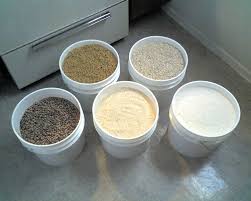A long-term food storage plan can help you in a variety of unexpected situations. Your family could face unemployment, long-term illness, a natural disaster or any of a number of personal or general emergencies that could prevent you from obtaining food from regular normal sources.
It is prudent to have sufficient food supplies to take care of your family in any circumstance. Some folks consider having sufficient long-term food storage to supply each family member from between 3-months to one year. The foods you choose to for your long-term emergency supply should keep for extended amounts of time when properly prepared and stored. The foods should provide you with the necessary nutrition to keep you healthy for the time you require.
The important principle is to have food items that your family eats and that store for long periods of time. Ideally, you would build a storage for your desired amount of time you want to be prepared for. Once you establish your supply it will be necessary to rotate through the items so that you are using up items and immediately replenishing them, keeping the amount of stored food the same over time. Using items in your storage allows for a natural cycle of rotation, ensuring that you keep items relatively fresh.
The suggestions below will help you formulate your family long-term food storage plan. Many of the items suggested below are whole grains and legumes which can have a significantly long-term storage time when properly prepared and stored.
Important Note: The information that follows is meant to be an overview of the basic storage foods and methods for long-term food storage. You should take time to study these methods more completely to ensure your efforts don’t result in spoiled foods or reduced storage life. It is important that you take every necessary precaution to keep food safe.
For those individuals who wish to purchase prepared long-term food storage there are a number of companies to consider. Prepackaged long-term food supplies will be the subject of other articles that deal with a variety of food storage options.
Items for Storage
This article focuses on self-prepared food storage. Among the best items to store are the following: Wheat, white rice, oats (rolled), corn, sugar, beans (various), pasta, potato flakes, apple slices, non-fat powdered milk, dehydrated carrots, dehydrated onions, and select soup mixes. Commercially prepared foods (freeze-dried, dehydrated, nitrogen packed, etc.) offer an increasing amount of variety at a significantly higher cost.
Foods Lasting 30 Years or More
Properly packaged, low-moisture foods stored at room temperature or cooler (24°C/75°F or lower) remain nutritious and edible much longer than previously thought, according to findings of recent scientific studies. Estimated shelf life for many products has increased to 30 years or more. Though not studied, sugar, salt, baking soda (essential for soaking beans), and vitamin C in tablet form also store well long-term. Some basic foods do need more frequent rotation, such as vegetable oil every 1 to 2 years.
While there is a decline in nutritional quality and taste over time, depending on the original quality of food and how it was processed, packaged, and stored, the studies show that even after being stored long-term, the food will help sustain life in an emergency.
| FOOD | NEW “LIFE-SUSTAINING” SHELF-LIFE ESTIMATES (IN YEARS) |
| Wheat | 30+ |
| White rice | 30+ |
| Corn | 30+ |
| Sugar | 30+ |
| Pinto beans | 30 |
| Rolled oats | 30 |
| Pasta | 30 |
| Potato flakes | 30 |
| Apple slices | 30 |
| Non-fat powdered milk | 20 |
| Dehydrated carrots | 20 |
The following suggested amounts are for one adult:
| QUANTITY FOR ONE MONTH | RECOMMENDED PRODUCTS | LONG-TERM STORAGE LIFE |
| 11.5 kg./ 25 lbs | Wheat, white rice, corn, and other grains | 30+ years |
| 2.5 kg. / 5 lbs | Dry beans | 30+ years |
Food Storage Quantity Recommendations For One Adult:
3-months: 75 lbs. wheat, white rice, corn, and other grains; 15 lbs. dry beans
6-months: 150 lbs. wheat, white rice, corn, other grains; 45 lbs. dry beans
12-months: 300 lbs. wheat, white rice, corn, other grains; 90 lbs. dry beans
Additional Considerations
You may also want to add other items to your longer-term storage such as sugar, nonfat dry milk, salt, baking soda, and cooking oil. To meet nutritional needs, also store foods containing vitamin C and other essential nutrients.
Avoid Costly Mistakes
- Storing poor quality food.
- Saving food for use only in an emergency.
- Storing what someone else outlines (not personalizing.
- Storing foods family does not like.
- Not rotating stored foods.
- Not developing habits or skills necessary to use storage.
- Placing storage in unaccessible locations.
- Placing storage in adverse storage conditions.
Source:
Utah State University Extension
Church of Jesus Christ of Latter-day Saints
Related articles:
Prepare A Short-term Emergency Food Supply

